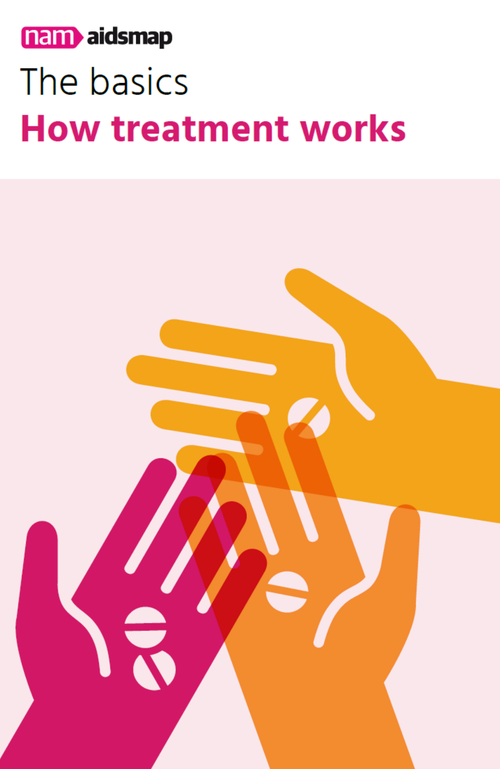
Key points
- There are more than 30 antiretroviral medications in six drug classes; these are listed below.
- Each class of drug attacks HIV at a different stage of the HIV lifecycle.
There are six main types (‘classes’) of antiretroviral drugs. Different classes work at different stages of the HIV lifecycle to stop it making new viruses. Generally, drugs from two (or sometimes three) classes are combined to ensure a combined attack on HIV.
The four main classes, which most people are treated with, target one of three viral proteins which control HIV’s lifecycle: reverse transcriptase, integrase and protease.
Historically, most people started HIV treatment with two drugs from the NRTI class combined with either one NNRTI, one protease inhibitor or one integrase inhibitor – hence, ‘triple therapy’. Increasingly, some people are offered a two-drug combination containing an integrase inhibitor and a drug from another class. These two-drug combinations containing an integrase inhibitor are just as effective as three-drug combinations.
Many of the HIV drug combinations used today combine two or three drugs in one pill (a ‘fixed-dose’ combination). Or you may be offered a combination that consists of two drugs in one pill, accompanied by a third drug in another pill.
Nucleoside/nucleotide reverse transcriptase inhibitors (NRTIs)
Nucleoside reverse transcriptase inhibitors (NRTIs), and nucleotide reverse transcriptase inhibitors (NtRTIs), often all referred to as NRTIs, work by targeting the action of an HIV protein called reverse transcriptase.
After the HIV virus releases its genetic material into a host cell, reverse transcriptase converts the viral RNA into DNA, a process known as ‘reverse transcription’. NRTIs disrupt the construction of a new piece of proviral DNA, thereby stopping the reverse transcription process and halting HIV replication.
This class of medications is sometimes referred to as the ‘backbone’ of a first-line HIV treatment combination. It includes the following drugs:
- Abacavir may be marketed under the name Ziagen, but generic versions are also available. Abacavir is included in the combination tablets abacavir/lamivudine and Triumeq.
- Emtricitabine is also known as Emtriva. It is included in the combination tablets emtricitabine/tenofovir disoproxil, Descovy, efavirenz/emtricitabine/tenofovir disoproxil, Biktarvy, Eviplera, Genvoya, Odefsey, Stribild and Symtuza.
- Lamivudine may be marketed under the name Epivir, but generic versions are also available. Lamivudine is included in the combination tablets abacavir/lamivudine, lamivudine/zidovudine, Triumeq, Delstrigo and Dovato.
- Tenofovir disoproxil may be marketed under the name Viread, but generic versions are also available. Tenofovir disoproxil is included in the combination tablets emtricitabine/tenofovir disoproxil, efavirenz/emtricitabine/tenofovir disoproxil, Delstrigo, Eviplera and Stribild.
- Tenofovir alafenamide, a newer formulation of tenofovir, is available in the combination tablets Biktarvy, Descovy, Genvoya, Odefsey and Symtuza.
- Zidovudine may be marketed under the name Retrovir, but generic versions are also available. Zidovudine is included in the combination tablet lamivudine/zidovudine.
Non-nucleoside reverse transcriptase inhibitors (NNRTIs)
Non-nucleoside reverse transcriptase inhibitors (NNRTIs) also target reverse transcriptase, but in a different way to NRTIs.
NNRTIs interfere with the reverse transcriptase enzyme by binding directly to it, blocking the reverse transcription process.
- Doravirine is also known as Pifeltro. Doravirine is included in the combination tablet Delstrigo.
- Efavirenz may be marketed under the name Sustiva, but generic versions are also available. Efavirenz is included in the combination tablet efavirenz/emtricitabine/tenofovir disoproxil.
- Etravirine is also known as Intelence.
- Nevirapine may be marketed under the name Viramune, but generic versions are also available.
- Rilpivirine is also known as Edurant when in tablet form. Rilpivirine is also available in the combination tablets Odefsey, Eviplera and Juluca. Rilpivirine is also available as an injection marketed under the names Rekambys (in Europe) and Cabuneva (elsewhere).
Integrase inhibitors
Integrase inhibitors target a protein in HIV called integrase which is essential for viral replication.
Integrase is responsible for inserting viral genomic DNA into the host chromosome. The integrase enzyme binds to host cell DNA, prepares an area on the viral DNA for integration, and then transfers this processed strand into the host cell’s genome.
Integrase inhibitors stop the virus from inserting itself into the DNA of human cells.
- Bictegravir is only available in the combination tablet Biktarvy.
- Dolutegravir is also known as Tivicay. It is included in the combination tablets Juluca and Triumeq, and Dovato.
- Elvitegravir is only available in the combination tablets Genvoya and Stribild.
- Raltegravir is also known as Isenstress.
- Cabotegravir is only available as an injection, marketed under the names Vocabria (in Europe) and Cabuneva (elsewhere).
Protease inhibitors (PIs)
Protease inhibitors (PIs) block the activity of the protease enzyme, which HIV uses to break up large polyproteins into the smaller pieces required for assembly of new viral particles. While HIV can still replicate in the presence of protease inhibitors, the resulting virions are immature and unable to infect new cells.
- Atazanavir may be marketed under the name Reyataz, but generic versions are also available. Atazanavir is included in the combination tablet Evotaz.
- Darunavir may be marketed under the name Prezista, but generic versions are also available. Darunavir is included in the combination tablets Rezolsta and Symtuza.
- Lopinavir is only available in the combination tablet lopinavir/ritonavir.
Booster drugs
Booster drugs are used to ‘boost’ the effects of protease inhibitors and other antiretroviral drugs. Adding a small dose of a booster drug to an antiretroviral makes the liver break down the primary drug more slowly, which means that it stays in the body for longer times or at higher levels. Without the boosting agent, the prescribed dose of the primary drug would be ineffective.
- Ritonavir is also known as Norvir. Ritonavir is included in the combination tablet lopinavir/ritonavir.
- Cobicistat is also known as Tybost. Cobicistat is included in the combination tablets Evotaz, Genvoya, Rezolsta, Stribild and Symtuza.
Single-tablet regimens
There are some fixed-dose pills that combine two or three antiretroviral drugs from more than one class into a single pill that is taken once a day. Find out more about these on our page One-pill-a-day HIV treatments.
Antiretrovirals for people with limited treatment options
Drugs from the following classes are mostly used when resistance has developed to first-line or second-line drugs. Because they work differently to existing drugs, they remain active against virus that has developed resistance to other antiretroviral classes.
Entry inhibitors stop HIV from entering human cells. These include fusion inhibitors, CCR5 inhibitors and attachment inhibitors.
In order to enter a host cell, HIV must bind to two separate receptors on the cell’s surface: the CD4 receptor and a co-receptor (CCR5 or CXCR4). Once HIV has attached to both, its envelope can fuse with the host cell membrane and release viral components into the cell. CCR5 inhibitors prevent HIV from using the CCR5 co-receptor by binding to it, blocking viral entry.
CCR5 inhibitors won’t work in everyone and are very rarely used for first-line treatment. You would have a test to see if this type of treatment would be effective before starting on it. One CCR5 inhibitor is licensed in Europe:
- Maraviroc is also known as Celsentri.
Fusion inhibitors works by stopping the fusion of the HIV envelope protein with the CD4 cell. One fusion inhibitor (enfuvirtide, also known as Fuzeon) is available, but is rarely used.
Attachment inhibitors bind to the gp120 portion of the HIV envelope protein that makes up the spikes on the surface of the virus. This prevents the virus from attaching to the CD4 receptor on T cells and other immune cells, which it uses to gain entry to the cells. One attachment inhibitor is available.
- Fostemsavir is also known as Rukobia.
Post-attachment inhibitors bind to the CD4 receptor on T-cells. They prevent the HIV gp120 protein from changing its shape to engage with co-receptors after it engages with the CD4 receptor. One post-attachment inhibitor is available.
- Ibalizumab is also known as Trogarzo.
Capsid inhibitors interfere with multiple stages of the HIV lifecycle. The HIV capsid is a cone-shaped structure that provides a container for viral proteins and enzymes. When the virus enters a target cell, the capsid opens up in a pre-programmed sequence to allow HIV proteins to integrate into the host cell’s DNA. Capsid inhibitors interrupt the opening and unpacking of the capsid, preventing HIV infection of a cell, as well as the assembly of new capsids. One capsid inhibitor is available.
- Lenacapavir is also known as Sunlenca.
Full image credit: A variety of antiretroviral drugs used to treat HIV infection. Credit: NIAID. Image available at www.flickr.com/photos/niaid/31793869534 under a Creative Commons licence CC BY 2.0.

